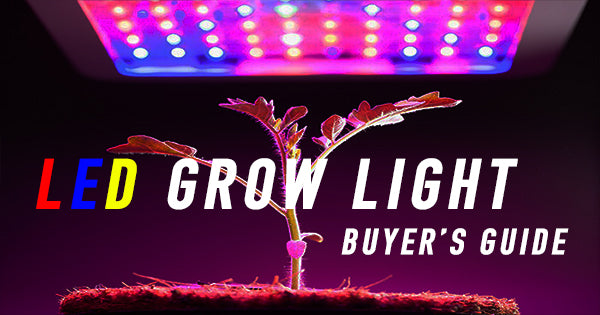
Getting lost in all the technical details of LED grow lights? Do you need advice about the best coverage area, spectrum to choose for your grow? Does PPFD and PAR efficiency matter? This article helps you through the options and language used in the details when choosing and purchasing your LED grow light set-up.

Coverage
The area to cover is a driving factor when determining the best LED grow light for your needs. Too much light wastes purchase and energy costs. Too little could leave you with disappointing growth and yield.

Consider the recommended coverage area first of all when looking through the specifications for an LED grow light. It's a measurement that applies primarily to smaller grows with a few fixtures or just one. Multiplying the figure for larger grows doesn't always apply - you may be able to use fewer fixtures thanks to the effect of lights nearby. We recommend seeking professional advice before selecting lighting for larger or commercial grows, and obtain a light plan, that sets out how many fixtures are required to reach target light levels in your specific area
Spectrum
Many LED grow light fixtures are full-spectrum or full-cycle. This simplifies the growing cycle, as the plants and lights can remain in place throughout the grow. In the past, growers needed to switch out light fixtures from MH to HPS as the growing cycle progressed. There are plenty of options for single all-purpose spectrums, switchable spectrums or LED units that can be swapped for the different growth phases.

Veg or Flower?
If you're considering separate rooms for veg and flower grows, consider different spectrums designed for specific growth stages. Veg fixtures are strong in the blue spectrum while flower spectrums are heavier on red.

Full Spectrum White Light
Many LED grow light manufacturers incorporate full-spectrum white light. This provides the width of spectrum and intensity required for growth and flowering in a single light. Full spectrum white light also includes green light, which drives photosynthesis through absorption deep in the leaves, where red or blue light does not penetrate.

The
NextLight Mega
is one of the LED Grow Lights that features a bright white light for increased production and large footprint it will supply to your canopy.
Wattage
You'll need a minimum of 32 watts per square foot. This is what the most efficient LED grow lights on the market require. Less efficient models will cover a smaller area effectively, or need supplemental lighting.
Wattage is a guide to the power usage of the light, not necessarily its output. One LED grow light may draw 515 watts and cover a 4.5 by 4.5 foot area, while another brand's fixture only covers 4' x 4' using 760 watts. Ideally you should look for the largest footprint and fewest watts combined. Other factors come into play, including power used by the driver and cooling devices such as fans.
Budget
What you can afford is going to be another guiding factor. Spending less brings size and quality limitations, but a more expensive light is not necessarily the most efficient, with the right spectrum or coverage for your needs. A good rule of thumb is to buy the best light your budget allows.
There you have it, 4 quick simple tips to help you choose the best LED grow light .
Ready to start growing indoors? Check out our growing LED grow light collection here.




